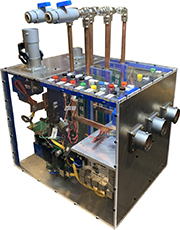Integrated generator-rectifier system and hardware development for high-power demonstration
Post-Doc Phuc Huynh with advisor A. Banerjee
Integrated generator-rectifier system in Fig. 1 has been shown to be a promising candidate to reduce the offshore wind energy levelized cost of electricity. The cost reduction is achieved through improved conversion efficiency and better reliability of the electro-mechanical energy conversion system compared to the conventional alternatives. These improvements are achieved by functionally integrating one active rectifier and several passive rectifiers into a multi-port generator. While the passive rectifiers processes most of the power at an ultra-high efficiency, the active rectifier regulates the entire system power to harvest the most energy from the wind turbine, or achieving maximum power-point tracking.
The project has been funded starting June 2019 by the Advanced Project Research Agency – Energy (APRA-E) through the prestigious APRA-E Open competition in 2018. A sub-kilowatt experimental system was built and successfully demonstrated the integrated system concept in early 2020. Since late 2020, the system has been in the scaling up progress to reach a 100x increase in power level. The increased power level requires a custom active-rectifier, which is shown in Fig. 2.

Figure 1. Integrated generator-rectifier system in a wind-energy application: the turbine shares a common shaft with the multi-port permanent-magnet synchronous generator. Ac power is converted to dc by series-stacked active and passive rectifiers. The dc output is connected to a stiff dc interface. The integrated generator-rectifier system performs maximum power-point tracking to extract the turbine maximum power.
